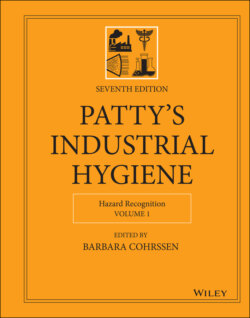Читать книгу Patty's Industrial Hygiene, Hazard Recognition - Группа авторов - Страница 118
4.3 Global EHS Perspective
ОглавлениеThe simplified strategies that underlie CB models created over the last two decades were part of an intentional design toward making them useful for small‐ and medium‐sized enterprises (SMEs). SMEs make up the vast majority of industries in economically developed countries and their smaller size typically renders their budget for EHS staffing from minimal to nonexistent. It was quickly realized that CB was also useful in economically transitional and economically developing countries, even in large‐scale enterprises, where EHS staffing is also lacking or their professions are unavailable altogether. According to International Labour Organization (ILO), there are over 2.8 billion workers and at least 2.8 million deaths annually are attributable to work‐related risks and 86% of these deaths are due to work‐related disease. In addition, each year there are also 374 million nonfatal accidents, and 160 million occupationally acquired diseases for the global workforce (25). The WHO estimates that, at best, 10–15% of these have no access to EHS professionals, leaving 2.5 billion workers facing unnecessary occupational risks daily (11). Therefore, the growth of CB was tied to the need to identify a simplified path to identify solutions to reduce work‐related risks through qualitative risk assessment methods for common workplace hazards that could be readily learned and applied by management and employees alike. CB has also proven itself in the scientific literature as being extremely useful in the absence of information, as in the absence of OELs or in emerging technologies like nanomaterials, and equally as essential in addressing the lack of sufficient EHS professional expertise in the workplace globally (26, 27).
The advancement of this approach on an international scale can be seen with the implementation of global harmonized system for the classification and labeling of chemicals (GHS). The GHS requires chemicals to be classified in a standardized format within a safety data sheet (SDS). SDSs are now required for the distribution of each chemical product on a global basis use this classification or derived hazard statements to objectively hazard rank chemicals and provide direct input into the CB models for chemical agents (16, 18, 19, 27). This requirement for the GHS SDSs creates a significant advantage in how CB can be used globally. The starting point for a standardized risk assessment and internationally consistent risk communication can now be either the GHS classification (see ILO Chemical Toolkit link in Online Resources section or the derived GHS Hazard Statements (see Control of Substances Hazardous to Health (COSHH) Essentials Technical Basis Online Resources section) which are available on each SDS and Supplier Label for each hazardous chemical. The GHS Classification and Hazard Statements are directly linked by the United Nations (UN) Purple Book; Revision 5 is now in use in North America and Revision 7 (see Online Resources section) is a planned replacement within two years. Combining GHS and these CB models (COSHH Essential e‐Tool and ILO Chemical Control Toolkit) creates objectivity in hazard ranking, removing bias from acute and chronic health hazards in risk assessment processes that may otherwise be a subjective exercise for individual IHs. Field level risk assessments often do not consider chronic and acute health risks, however, combining SDSs available at worksites with CB models will enable a field professional's understanding of these hazards and generally identify potential control approaches associated with the RLs. Combining SDS and CB models turns a subjective process into a standardized, objective process using globally accepted CB principals and a risk communication process that leads to a consistent application of control approaches for chemical agents. In addition, in areas of the world that lack appropriate EHS staffing, an objective hazard ranking can be achieved by associating GHS Hazard Classifications with the CB Hazard Band structures that provide an effective risk communication for workers to understand the relative risk of workplace chemicals.
